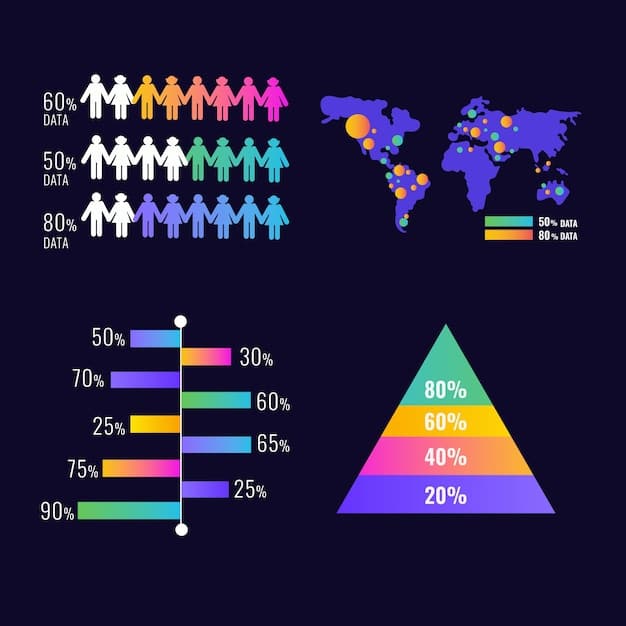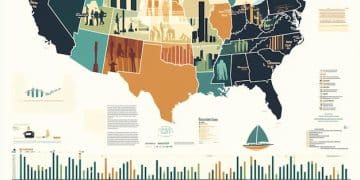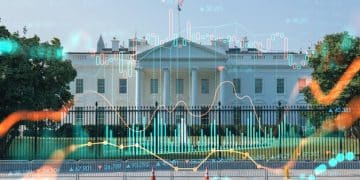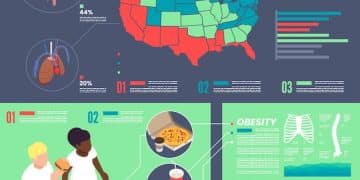2025 US Census Data: 5 Key Demographic Shifts & Policy Impact

The 2025 US Census Data: 5 Key Demographic Shifts Impacting National Policy reveals crucial changes in population dynamics, including aging, ethnic diversity, urban shifts, family structures, and economic disparities, directly influencing future policy decisions across healthcare, education, infrastructure, and social programs.
The landscape of the United States is in constant flux, a dynamic tapestry woven from millions of individual lives and choices. The upcoming release of the 2025 US Census Data: 5 Key Demographic Shifts Impacting National Policy is poised to offer a profound snapshot of this transformation, revealing shifts that will undoubtedly shape the nation’s future policies and priorities. Understanding these underlying demographic currents is not merely an academic exercise; it’s a vital prerequisite for effective governance, equitable resource allocation, and a prosperous society.
The Graying of America: Aging Population and Its Challenges
One of the most profound shifts highlighted by recurring census data is the escalating age of the American population. This isn’t a sudden phenomenon but a steady, inexorable march of demographics, driven by falling birth rates and increasing life expectancies. The 2025 data is expected to underscore this trend dramatically, presenting both opportunities and significant policy challenges.
As the median age rises, so too do the demands on social security, healthcare systems, and elder care services. The ratio of retirees to active workers—the dependency ratio—is a critical metric, and its projected trajectory suggests increased strain on existing support structures. This shift requires proactive planning and innovative solutions.
Healthcare and Social Security Strain
The aging population directly impacts the viability of entitlement programs. Medicare and Social Security face mounting pressure as more citizens draw benefits for longer periods. This necessitates a national conversation about sustainable funding and potential reforms.
- Increased Healthcare Costs: Older adults typically require more medical care, driving up national healthcare expenditures.
- Social Security Solvency: Fewer younger workers contributing per retiree strain the system’s financial health.
- Workforce Shortages: Industries reliant on younger labor may experience significant gaps, impacting productivity and innovation.
Beyond the fiscal implications, there’s a growing need for specialized medical services, from geriatric care to advanced treatments for age-related diseases. The demand for caregivers, both professional and informal, is also skyrocketing, prompting questions about training, wages, and support for these vital roles.
Rethinking Retirement and Workforce Participation
The traditional model of retirement at 65 is also being challenged. Many older Americans are remaining in the workforce longer, whether by choice or necessity. This trend can offer valuable experience and mentorship but also requires adaptations in workplace culture and policies.
Policies encouraging phased retirement, flexible work arrangements, and lifelong learning initiatives become increasingly relevant. There’s also an opportunity to tap into the expertise of older workers, potentially mitigating some of the workforce challenges posed by demographic shifts.
Understanding the implications of an aging population is crucial for policymakers. It requires balancing the needs of a growing senior demographic with supporting a vibrant, productive workforce. This isn’t just about financial sustainability; it’s about fostering a society where all age groups can thrive and contribute meaningfully.

The Mosaic Nation: Growing Ethnic and Racial Diversity
The United States has always been a nation of immigrants, a melting pot of cultures and backgrounds. However, the 2025 Census is expected to highlight an accelerating pace of ethnic and racial diversification across the country. This profound shift is reshaping communities, economies, and political landscapes.
The increasing presence of various ethnic groups brings a richness of perspectives, languages, and cultural traditions. It also presents unique policy considerations regarding integration, equity, and representation. The ways in which these diverse populations interact and contribute will define the American experience for generations to come.
Impact on Education and Public Services
Greater diversity directly impacts public services, particularly education. Schools are increasingly serving students from a wide array of linguistic and cultural backgrounds, necessitating tailored curricula and support systems. This includes expanding bilingual education programs and culturally competent teaching methods.
- Multicultural Curricula: Need for educational materials that reflect and celebrate diverse heritages.
- Language Access: Increased demand for translation and interpretation services in public agencies.
- Inclusive Public Spaces: Rethinking urban planning and public facilities to cater to diverse cultural practices.
Healthcare providers, too, must adapt. Cultural competency training for medical staff, access to medical information in multiple languages, and an understanding of varying health beliefs are becoming indispensable to ensure equitable health outcomes.
Political Representation and Economic Contributions
The changing ethnic makeup of the US population also has significant political ramifications. Shifting demographics can influence voting patterns, electoral outcomes, and the priorities of elected officials. Ensuring fair representation and addressing the concerns of all communities becomes paramount.
Economically, diverse populations are often engines of innovation and entrepreneurship. Immigrant communities, in particular, have historically high rates of business formation, contributing significantly to job creation and economic growth. However, addressing potential wage gaps and ensuring equal opportunities remains a key policy challenge.
Embracing and understanding this growing diversity is not just a matter of social justice; it’s an economic imperative. Policies that foster inclusion, celebrate cultural heritage, and dismantle systemic barriers will be crucial for the nation’s continued strength and prosperity.
Urbanization and Suburban Expansion: Shifting Geographic Centers
While the image of bustling metropolises might suggest peak urbanization, the 2025 Census data is expected to reveal a more nuanced picture: continued growth in major urban centers, coupled with significant expansion in surrounding suburban areas. This geographic redistribution of the population has far-reaching implications for infrastructure, housing, and environmental policy.
Many people are drawn to cities for economic opportunities, cultural amenities, and diverse lifestyles. However, the high cost of living and desire for more space often push families and individuals into the suburbs, leading to a sprawling growth pattern. This dynamic creates unique challenges for regional planning and resource management.
Infrastructure Demands and Commuter Challenges
Both urban and expanding suburban areas face immense pressure to adapt their infrastructure. Roads, public transportation, utility systems, and broadband internet must keep pace with population growth. For cities, this often means upgrading aging systems; for suburbs, it involves building new ones from the ground up.
- Traffic Congestion: Increased commuter traffic strains existing road networks and public transit.
- Housing Affordability: Rising demand in both urban and desirable suburban areas drives up housing costs.
- Utility Expansion: Extending water, sewer, and power grids to new developments requires substantial investment.
Commuting patterns become more complex, impacting everything from air quality to personal well-being. Policies promoting public transit, walkable communities, and mixed-use developments are vital for creating sustainable living environments.
Environmental and Land-Use Implications
The expansion of suburban areas often encroaches on natural habitats and agricultural lands. This “urban sprawl” has significant environmental consequences, including habitat loss, increased carbon emissions from longer commutes, and increased impervious surfaces contributing to stormwater runoff.
Effective land-use planning becomes critical. Policies that encourage compact development, preserve green spaces, and protect agricultural lands can help mitigate these negative impacts. Furthermore, investments in renewable energy and sustainable building practices become more urgent as urban and suburban footprints grow.
The concentration of populations in certain areas also brings heightened risks during natural disasters, requiring robust emergency planning and resilient infrastructure. Understanding where people are choosing to live is fundamental to preparing for future challenges and building adaptable communities.
Evolving Family Structures: Beyond the Traditional Nuclear Model
The traditional nuclear family, long considered the bedrock of American society, has been steadily diversifying. The 2025 US Census will likely affirm and elaborate on this trend, showing a proliferation of family structures that demand a re-evaluation of social policies and support systems. This evolution reflects changing societal values, economic pressures, and individual choices.
Single-parent households, blended families, same-sex couples raising children, multi-generational homes, and individuals living alone are all becoming more common. These shifts are not just statistics; they represent millions of lives with unique needs and contributions that must be acknowledged and supported through inclusive policy-making.
Support Systems for Diverse Families
Public services and social programs, historically designed with the nuclear family in mind, often struggle to adequately support these new configurations. Childcare policies, for instance, need to be flexible enough to accommodate single parents, grandparents raising grandchildren, or parents working non-traditional hours.
- Flexible Childcare Options: Programs must cater to varied work schedules and family setups.
- Caregiver Support: Policies to assist individuals caring for aging parents or children with special needs.
- Housing for Multi-Generational Families: Addressing zoning and housing code limitations for shared living.
Legal frameworks, too, require modernization to recognize and protect the rights and responsibilities within these varied family units. This includes everything from inheritance laws to healthcare decision-making for non-traditional partners or family members.
Economic Implications and Social Cohesion
The economic well-being of families is heavily influenced by their structure. Single-parent homes, for example, often face greater financial strain. Policies addressing income inequality, affordable housing, and access to quality education become even more critical in this context.
On a broader societal level, understanding these evolving structures can foster greater social cohesion by promoting empathy and tailored support. Recognizing that “family” is a broad and encompassing term allows for more effective community building and resource allocation.
Acknowledging and adapting to the diversity of family structures is essential for creating a truly inclusive and equitable society. Policymakers must move beyond outdated assumptions and design programs that reflect the reality of how Americans live, love, and raise their families today.

Economic Inequality and Shifting Wealth Distribution
The 2025 US Census data is anticipated to offer stark insights into the persistent and potentially widening gaps in economic inequality across the nation. This isn’t merely about income disparity but also encompasses wealth distribution, access to opportunities, and the varying economic fortunes of different demographic groups and geographic regions. Understanding these trends is paramount for developing policies that promote equitable growth and social mobility.
Factors such as automation, global economic shifts, and differential access to education and capital contribute to these disparities. The census data will provide empirical evidence to quantify these gaps and reveal their concentrated impacts on specific populations or areas, informing targeted interventions.
Policy Responses to Wealth Disparity
Addressing economic inequality requires a multi-faceted approach, touching upon taxation, education, labor policies, and social safety nets. The data from the 2025 Census will be critical in identifying where these policies need to be most aggressively applied and for whom.
- Education Access: Investing in early childhood education and affordable higher education to equip individuals for future jobs.
- Fair Labor Practices: Policies like minimum wage increases and protections for gig economy workers.
- Progressive Taxation: Adjusting tax structures to ensure a more equitable contribution from all income levels.
Furthermore, policies aimed at fostering small business growth and entrepreneurship in underserved communities can help create local wealth and reduce reliance on external economic forces.
Regional Disparities and the Digital Divide
Economic inequality is often closely tied to geography. Some regions may thrive while others struggle with declining industries, a lack of investment, or the outmigration of skilled workers. The census will highlight these regional differences, pointing to areas requiring specific economic development strategies.
The “digital divide,” or the gap in access to reliable and affordable internet, is another critical component of modern economic inequality. Communities without adequate broadband infrastructure are often left behind in terms of educational opportunities, job searching, and access to essential services.
Closing these gaps isn’t just about economic fairness; it’s about national resilience and competitiveness. Policies that foster inclusive economic growth, bridge geographical divides, and ensure equitable access to essential resources are vital for a strong and cohesive society.
Conclusion
| Key Shift | Brief Description |
|---|---|
| 👴 Aging Population | Increasing median age, impacting social security, healthcare, and workforce. |
| 🌍 Ethnic Diversity | Growing multi-ethnic and multicultural presence, affecting education and public services. |
| 🏙️ Urban/Suburban Growth | Population concentration in urban areas and expanding suburbs, straining infrastructure. |
| 👨👩👧👦 Family Evolution | Diversifying family structures, requiring updated social support and policy recognition. |
Frequently Asked Questions about 2025 US Census Data
The 2025 US Census data is crucial because it provides an updated, comprehensive picture of the nation’s demographics. These insights directly influence federal funding allocations, electoral district boundaries, and the planning of essential services like healthcare, education, and infrastructure for the next decade. It’s a foundational tool for informed policy-making.
An aging population primarily impacts national policy through increased strain on social security and healthcare systems. It necessitates discussions about funding sustainability for programs like Medicare, prompts changes in workforce participation models, and creates demand for specialized elder care services and infrastructure adaptations to support older citizens more effectively.
Growing ethnic diversity requires policies that promote inclusion and equitable access to resources. This includes adapting educational curricula to be more multicultural, ensuring language access in public services, fostering cultural competency in healthcare, and potentially realigning political representation to reflect demographic shifts in communities across the nation.
Shifting urban and suburban populations create immense pressure on infrastructure, demanding investments in transportation, housing, and utilities. Policies must address housing affordability, mitigate traffic congestion, and implement sustainable land-use planning to manage urban sprawl, protect natural resources, and ensure resilient communities capable of supporting growth.
Evolving family structures challenge traditional policy frameworks often designed for nuclear families. This necessitates modernizing support systems like childcare and elder care to be more flexible, re-evaluating legal frameworks to recognize diverse family units, and crafting economic policies that provide adequate support, particularly for single-parent or multi-generational households, ensuring social equity.
Conclusion
The 2025 US Census data will be far more than a collection of numbers; it will serve as a critical mirror reflecting the evolving face of the nation. The five key demographic shifts — an aging population, increasing ethnic diversity, dynamic urbanization and suburban expansion, evolving family structures, and persistent economic inequalities — are not isolated phenomena. They are interconnected forces that collectively present both significant challenges and unique opportunities. For policymakers, researchers, and citizens alike, a deep engagement with this data is essential. It provides the foundation upon which effective, equitable, and forward-thinking policies can be built, ensuring that the United States continues to adapt and thrive in an ever-changing world. Addressing these shifts proactively, rather than reactively, will be key to shaping a resilient and prosperous future for all Americans.





